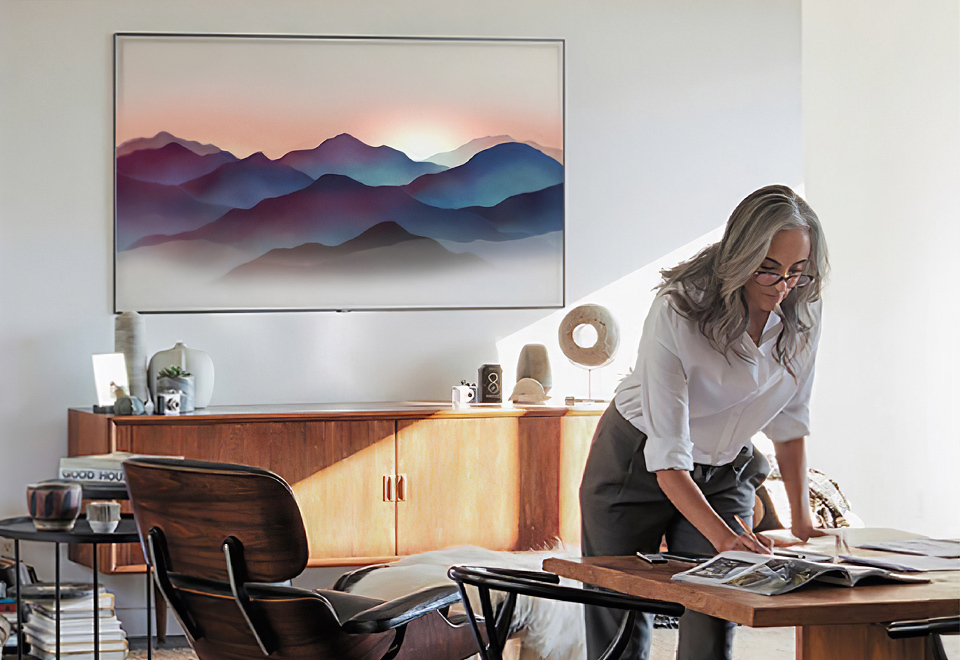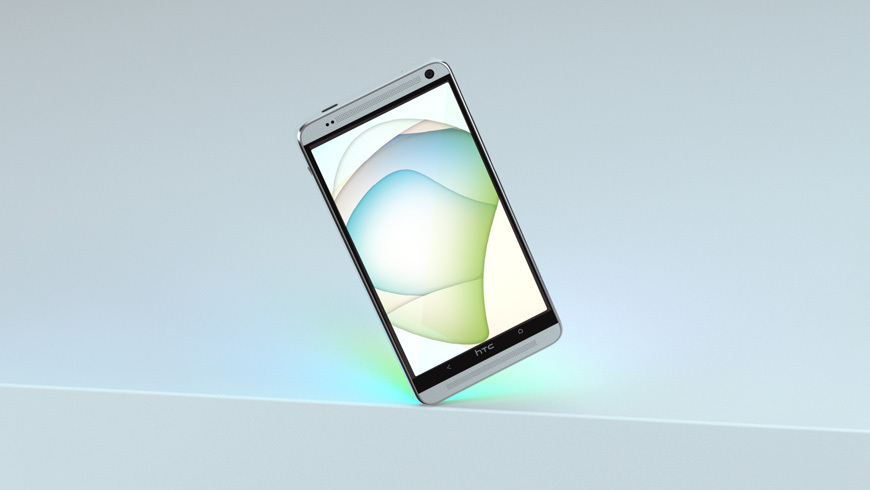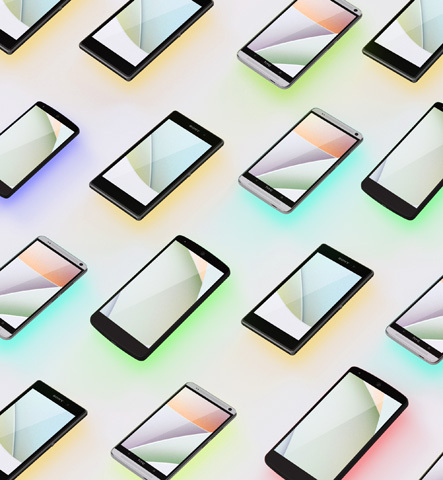The omnipresence of screens has taken over our personal life in our homes and hands, even on our bodies as smart watches. With each new version, the popularity of devices rises simultaneously through enhanced functionality and more minimalistic hardware design. With TV and smartphone screens growing in size and quality, visual content turns into a main stage for brand identity and recognition. Design and media consumption are influencing each other mutually and reflecting current trends towards individualism: The interplay of hardware and software becomes more symbiotic than ever. What does that mean for the content creation?
Content for Future Screens
Opening new visual worlds by bridging design and technology: How do we create visual content for increasingly minimalistic hardware in times of fast-paced technological development?
Unique art content turns the Samsung QLED TV into more than a screen with the Samsung Ambient Mode that elegantly integrates it into the room.
Integration on all levels of development, function and design
Straightforwardly said, from a design perspective, there is much more to it than creating beautiful, moving visuals. For the visual output, as well as in the development process, the demand is to think holistically in new dimensions of personalization and integration. To find the balance between a visual language that represents brand identity and recognizes individualization is one part of the journey that continues on a complex technical level at the intersection of hardware, software and design.
— For the visual output as well as in the development process, the demand is to think holistically in new dimensions of personalization and integration.

Different types of screens require different types of visuals: From a transparent screen appearance of Samsung Ambient Mode to the vertical oriented Samsung Sero screen, the custom-tailored and data-driven contents orchestrate the functions of the Samsung TVs.
In 2017 we started to work closely together with Samsung to develop unique content for their QLED TVs. The Ambient Mode series was launched with the claim »see nothing else«. Its functionality to adapt to the respective ambience of the space is combined with pre-installed aesthetic content that can be personalized through data-driven visuals. Featuring this Ambient Mode, the series successfully introduced the new generation of TVs to the living room. Behind the seamless interplay of hardware and software stand complex considerations regarding the technical advancement in the background and the integration of aesthetic and emotional aspects on the visual level. To develop and transfer the content smoothly, early involvement in the project and the in-depth collaboration throughout the development process were essential. In the dynamic exchange with the UI/UX development team, our role evolved into the interface between design and technology. On several levels, such as technical and look development, software compatibility, and visual language, the profound integration was established as the key in the successful long term collaboration and shown as essential for increasingly complex projects with new screen formats like Samsung Sero and Samsung The Wall.
— Behind the seamless interplay of hardware and software stand complex considerations regarding the technical advancement in the background and the integration of aesthetic and emotional aspects on the visual level.

Individual, yet aesthetic: The art content shown via the Samsung Ambient Mode adds a contemporary accent to the living room, accelerating modern interiors to a new level.
The significance of an integrative approach when working at the intersection of technology and design is clearly shown through the symbiosis of hardware and software. The enhanced and more complex functionality of software through data-driven and real-time content like in the Samsung series opens new dimensions. Exploring such novel formats opens up new perspectives and gives opportunities to actively co-create new aesthetic worlds.
Personalizing user experiences through interactive, data-driven visuals
Of all devices, most of the screen time is probably spent on the smartphone. Not only the amount of time, but also the kind of interaction and communication with this device makes our connection to it especially personal. In 2019, smartphone producer OnePlus released their 7 series, focused on smooth reactivity. As the visual presence of the hardware steps back with a larger screen size and no home button, functionality and visual language come forward to represent the uniqueness of the product and the brand.

Tomorrow’s smartphone is more than a device: the live wallpapers for the OnePlus 7 and 8 series seamlessly reflect the quick responsiveness, interactivity and personalization of the interaction with the screen.
For the hero image and live wallpapers of the OnePlus 7, and later the 8 series, we developed reactive and data-driven visuals together with the OnePlus UI/UX development team. With each swipe and other user activities, the visuals change accordingly, taking interactivity to a new level with high responsiveness and smooth handling. Individual input, like weather information or personal user data, transfers into the visual performance to define a custom tailored experience. One premise to combine such technical features with aesthetic visuals and smooth functionality is profound experience in the realm of technology and in-depth research.
— Within the design and development process the demand is to stay curious and to expand one’s own knowledge again and again to find possibilities that lay beyond the already known.
To find possibilities that lay beyond what is already known for specific devices like the smartphone, curiosity pays off. A few years earlier we were involved in a research project for Google, where we developed prototypes for possible phone interaction. In the retrospective, similarities in the structure of hardware and software in both projects, OnePlus and Google, become clear, however with completely different requirements on the technical and visual levels. It is a vivid example to illustrate the fast development of technology and how it challenges and opens new possibilities at the same time. The design and development processes demand curiosity and the ability to enlarge one's own knowledge again and again to find possibilities that lay beyond the already known.

By developing integrative concepts we create a symbiotic relationship between hardware and software to augment the user experience for devices like a smartphone or smartwatch.
Bridging technological progress and design through research
With this increasingly fast-paced progress of technological development, the integration of hardware, software and design becomes more complex on a daily basis. We regard this complexity as an invitation to experiment and explore new opportunities for different kinds of devices, technically as well as visually. For an innovative approach like this, it is especially beneficial to be involved at an early stage of the process to develop and include progressive concepts and ideas for future devices which are still in development. With an interdisciplinary team of creatives and developers, we work closely with the clients’ in-house teams to support through every phase of the creation process - from initial planning and the definition of technical requirements up to final content creation and implementation.
— Ongoing, intense research enables us to help refine and adapt existing concepts into new realms or develop completely new ideas for future devices.


Research and development are a matter of both experimenting and expertise. By staying curious and blending knowledge with new input we achieve desired results and beyond.
Especially during an early research process, the extent of our creative input and technical expertise can vary widely depending on the technology and visual framework. This can range from the analysis of available data sources and the development of concepts to turn data into unique, personalized visuals, to the creation of bespoke hardware prototypes. For Google, for example, we explored the possibilities that lie in combining hardware and software in new ways. This led us to experiment with concepts like shared wallpapers that connect users in a subtle way without explicitly communicating with each other, as well as prototypes for a built-in LED-based lighting system to augment a phone’s ability to communicate with the user in a discrete, ambient way. In other words: ongoing, intense research enables us to help refine and adapt existing concepts into new realms or develop completely new ideas for future devices. Various collaborations with leading tech companies bridge newly introduced technology with integrative design that communicates the right message. Being able to jump in during different phases of the process, from early research to integration of a new concept, has proven to be especially fruitful – and to be one of our strongest competencies. It leads to both the exploration of infinite possibilities of visual content and to the active shaping of technological progress.
Is this resonating? Get in touch if you would like us to jump on a project and explore untouched possibilities!


